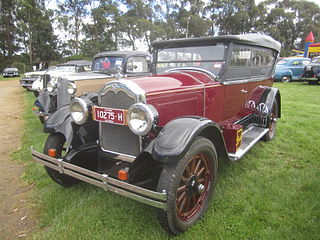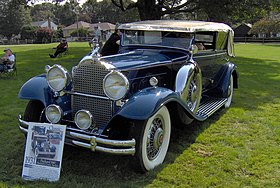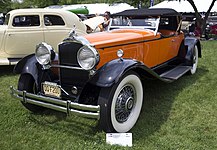
Packard was an American luxury automobile company located in Detroit, Michigan. The first Packard automobiles were produced in 1899, and the last Packards were built in South Bend, Indiana in 1958.

LaSalle was an American brand of luxury automobiles manufactured and marketed, as a separate brand, by General Motors' Cadillac division from 1927 through 1940. Alfred P. Sloan, GM's Chairman of the Board, developed the concept for four new GM marques - LaSalle, Marquette, Viking and Pontiac - paired with already established brands to fill price gaps he perceived in the General Motors product portfolio. Sloan created LaSalle as a companion marque for Cadillac. LaSalle automobiles were manufactured by Cadillac, but were priced lower than Cadillac-branded automobiles, were shorter, and were marketed as the second-most prestigious marque in the General Motors portfolio. LaSalles were titled as LaSalles, and not as Cadillacs. Like Cadillac — named after Antoine de la Mothe Cadillac — the LaSalle brand name was based on that of another French explorer, René-Robert Cavelier, Sieur de La Salle.

The Chrysler Royal was a full-size car produced by the Chrysler Corporation in the United States. It was first released in 1933 and continued being built until 1934. Then, the model ended production and did not return until 1937 - continuing until 1950.
Du Pont Motors was founded by E. Paul du Pont to produce marine engines for the Allied nations during World War I. After the war, Du Pont Motors produced extremely high-end automobiles. The cars were manufactured in Wilmington, Delaware.

The Chrysler Imperial, introduced in 1926, was Chrysler's top-of-the-line vehicle for much of its history. Models were produced with the Chrysler name until 1954, after which it became a standalone brand; and again from 1990 to 1993. The company positioned the cars as a prestige marque to rival Cadillac, Continental, Lincoln, Duesenberg, Pierce Arrow, Cord, and Packard. According to Antique Automobile, "The adjective ‘imperial’ according to Webster's Dictionary means sovereign, supreme, superior or of unusual size or excellence. The word imperial thus justly befits Chrysler's highest priced model."

The Cadillac V-63 is a large luxury automobile that was introduced in September 1923 by Cadillac as a 1924 model, replacing the previous Type 61. It used the GM C platform and was replaced by the Cadillac Series 355 in 1931. It retained the name Cadillac V8 introduced with the previous generation Cadillac Type 51.

The Packard Twelfth Series One-Twenty is an automobile produced by the Packard Motor Car Company of Detroit, Michigan, from 1935 to 1937 and from 1939 through the 1941 model years. The One-Twenty model designation was derived from the wheelbase, and it was replaced by the Packard 200.

The Lincoln K series is a luxury vehicle that was produced by the Lincoln Motor Company. The second motor line produced by the company, the Model K was developed from the Model L, including a modernized chassis on a longer wheelbase. In 1931, Lincoln introduced a V-12 engine, becoming a feature of the company for nearly 20 years.

The Cole Motor Car Company was an early automobile maker based in Indianapolis, Indiana. Cole automobiles were built from 1908 until 1925. They were quality-built luxury cars. The make is a pioneer of the V-8 engine.

The Hudson Super Six Coach is an automobile which was first manufactured by the Hudson Motor Car Company of Detroit, Michigan in 1916. The first model was kept in production until 1928. The nameplate was revived for a rebadged Essex for 1933, and then returned again from 1940 until 1951, aside from a wartime hiatus. The 1951s were actually called "Hudson Super Custom Six".

The Western Antique Aeroplane and Automobile Museum (WAAAM) is located in Hood River, Oregon, United States, adjacent to the Ken Jernstedt Memorial Airport. WAAAM is a nonprofit 501(c)(3) organization committed to the preservation of, and education about aviation, automobile, and other historic transportation-related relics.

The Packard Ninth Series Light Eight Model 900 was an automobile model produced by the Packard Motor Car Company of Detroit, Michigan only during model year 1932. The Light Eight was planned as a new entry model, building off the 1928 Packard Six. It competed in the upper middle-class with makes like GM's Companion Brand LaSalle, Marquette and Chrysler's DeSoto, and the top-level products from Studebaker, Hudson, and Nash. The marketing objective was to add a new market segment for Packard during the depression.

The Buick Master Six, also denoted Series 40 and Series 50 based on the wheelbase used, was an automobile built by Buick from 1925 to 1928 and shared the GM B platform with the Oldsmobile Model 30. Previously, the company manufactured the Buick Six that used the overhead valve six-cylinder 242 cu in (4.0 L) engine in their high-end cars, and the Buick Four for smaller, less-expensive cars. Starting with 1918, they dropped the four-cylinder engine and designed a small six, which they called the Buick Standard Six, to replace that end of the market. They coined the name "Master Six" for the high-end cars, now powered by the 255 cu in (4.2 L) engine released the year before. The yearly changes were a result of a new business philosophy called planned obsolescence
The Dana Point Concours d'Elegance is an automotive charitable event held each year on the Monarch Beach Golf Links at the Monarch Beach Resort Resort in Dana Point, California. It is operated primarily as a Classic Car Club of America (CCCA) Concours, with additional classes showcasing interesting and relevant automobiles and motorcycles. The 2010 event was held Sunday, June 27, 2010 moving from its traditional date in September.

The Lincoln L series is the first automobile that was produced by the Lincoln Motor Company. Introduced in 1920, the L series would continue to be produced after the bankruptcy of Lincoln in 1922 and its purchase by Ford Motor Company.

The Packard Motor Car Company introduced their first four-cylinder engine in 1903 initially as a top level car along with the Packard Model F. It was their only automobile offered and exclusively used a four-cylinder engine from 1903 until 1912 and established Packard as a luxury car maker, and was replaced by the 1913 Packard Six.

The Chrysler Six was a series of cars that were all installed with the Chrysler Straight Six when the company assumed operations of the Maxwell Automobile Company in 1924, and Chalmers Automobile Company in 1926. The Chrysler Six initially consisted of several Models, then Series designations that originally declared the approximate top speed each vehicle was able to consistently maintain, then each series number was incrementally updated every new model year, and each series was offered in several body style choices. The engines were technically advanced for their time and were entered in the 24 Hours of Le Mans for 1925, 1928 and 1929.

The Packard Twelve was a range of V12-engined luxury automobiles built by the Packard Motor Car Company in Detroit, Michigan. The car was built from model year 1916 until 1923, then it returned 1933 until 1939. As a sign of changing times, the majority of second generation Packard Twelves received standard bodywork, with custom bodywork gradually losing favor. Many of the custom cars were actually only "semi-customs", with Dietrich assembling Packard-made bodies with special touches.

The Oldsmobile Six, also known as the Model 53, 54 and 55 (1913-1915) then a brief cancellation until it reappeared as the Model 37, 37A and 37B (1917-1921) was a top level sedan along with the Oldsmobile Series 40 junior vehicle produced by GM's Oldsmobile Division and was manufactured at Lansing Car Assembly in Lansing, Michigan. It replaced the Series 28 also known as the "Oldsmobile Autocrat" and was replaced by the Oldsmobile Model 30 in 1927, and shared wheelbases with the Buick Six. It continued to use the T-head engine for two years. The various bodystyles were supplied by Fisher Body of Detroit, MI. It competed with the Chevrolet Series C Classic Six as Chevrolet was an independent company before becoming a division in 1917. Oldsmobile also shared technology with GMC for commercial and industrial products.

The Oldsmobile Light Eight was an automobile produced by the Oldsmobile Division of General Motors in roadster, two-door coupe, four-door sedan from between 1916 and 1923. It was powered by a sidevalve V8 engine, the maker's first, and shared with the 1916 Oakland Model 50.






























